Traditional Usage of Wild Fauna among the Local Inhabitants of Ladakh, Trans-Himalayan Region
Abstract
Simple Summary
Abstract
1. Introduction
2. Materials and Methods
2.1. Study Area
2.2. Survey and Data Collection
2.3. Data Analysis
3. Results and Discussion
3.1. Local Respondents and Their Perceptions about Wildlife
- The majority (54%) of participants considered wildlife as part of the ecosystem and culture and had keen belief that wildlife was to be conserved and protected.
- A second class (36%) observed wildlife as a threat to humans and agriculture, and,
- A small minority (10%) had no preconceived ideas.
3.2. Animal Usage Classification
3.3. Preference Analysis
3.4. Medicinal Uses of Animal Species
3.5. Wildlife Diversity and Threats
4. Conclusions
Author Contributions
Funding
Acknowledgments
Conflicts of Interest
References
- Alves, R.R.N.; Rosa, I.L. Why study the use of animal products in traditional medicines? J. Ethnobiol. Ethnomed. 2005, 1, 1–5. [Google Scholar]
- Lohani, U. Man-animal relationships in Central Nepal. J. Ethnobiol. Ethnomed. 2010, 6, 31. [Google Scholar] [CrossRef] [PubMed]
- Marques, J.G. Fauna medicinal: Recurso do ambiente ou ameaça à biodiversidade. Mutum 1997, 1, 4. [Google Scholar]
- Costa-Neto, E.M.; Marques, J.G. Conhecimento ictiológico tradicional ea distribuição temporal e espacial de recursos pesqueiros pelos pescadores de Conde, Estado da Bahia, Brasil. Etnoecológica 2000, 4, 56–68. [Google Scholar]
- Zhang, Z.; Wang, F. Effects of crude extract of earthworm on promoting blood circulation to removing stasis. Soil Biol. Biochem. 1992, 24, 1247–1251. [Google Scholar]
- Unnikrishnan, P. Animals in Ayurveda. Amruth Suppl. 1998, 1, 1–15. [Google Scholar]
- Oudhia, P. Traditional knowledge about medicinal insects, mites and spiders in Chhattisgarh, India. Insect Environ. 1995, 4, 57–58. [Google Scholar]
- Beetz, A.; Uvnäs-Moberg, K.; Julius, H.; Kotrschal, K. Psychosocial and psychophysiological effects of human-animal interactions: The possible role of oxytocin. Front. Psychol. 2012, 3, 234. [Google Scholar] [CrossRef]
- Yamakawa, M. Insect antibacterial proteins. J. Sericult. Sci. Jpn. 1998, 67, 163–182. [Google Scholar]
- Goodman, W.G. Chitin: A magic bullet. Food Insect News 1989, 2, 6–7. [Google Scholar]
- Kunin, W.; Lawton, J.H.; Kunin, A.A.; Lawton, H. Does biodiversity matter? Evaluating the case for conserving species. Biodivers. Biol. Numbers Differ. 1996, 1, 283–308. [Google Scholar]
- Bisset, N.G. One man’s poison, another man’s medicine. J. Ethnobiol. 1991, 32, 71–81. [Google Scholar] [CrossRef]
- Daly, J.W. Amphibian skin: A remarkable source of biologically active arthropod alkaloids. J. Med. Chem. 2003, 46, 445–452. [Google Scholar] [CrossRef] [PubMed]
- Clarke, B.T. The natural history of amphibian skin secretions, their normal functioning and potential medical applications. Biol. Rev. 1997, 72, 365–379. [Google Scholar] [CrossRef]
- Pant, S.; Rinchen, T.; Butola, J.S. Indigenous knowledge on bio-resources management for sustainable livelihood by the cold desert people, Trans-Himalaya, Ladakh, India. Ind. J. Nat. Prod. Resour. 2018, 9, 168–173. [Google Scholar]
- The Jammu and Kashmir Reorganisation Bill. 2019. Available online: http://www.prsindia.org/sites/default/files/bill_files/Jammu%20and%20Kashmir%20Reorganisation%20Bill%2C%202019.pdf (accessed on 30 November 2020).
- Rizvi, J. Ladakh: Crossroads of High Asia; Oxford University Press: Oxford, UK, 1999. [Google Scholar]
- Bray, J. Ladakhi history and Indian nationhood. South Asia Res. 1991, 11, 115–133. [Google Scholar] [CrossRef]
- Rajashekariah, K.; Chandan, P. Value Chain Mapping of Tourism in Ladakh; WWF-India: New Delhi, India, 2013. [Google Scholar]
- Fox, J.L.; Nurbu, C.; Chundawat, R.S. The mountain ungulates of Ladakh, India. Biol. Conserv. 1991, 58, 167–190. [Google Scholar] [CrossRef]
- Namgail, T. Mountain ungulates of the Trans-Himalayan region of Ladakh, India. Int. J. Wilderness 2009, 15, 35–40. [Google Scholar]
- Rawat, G.S.; Adhikari, B.S. Floristics and distribution of plant communities across moisture and topographic gradients in Tso Kar basin, Changthang plateau, eastern Ladakh. Arct. Antarct. Alp. Res. 2005, 37, 539–544. [Google Scholar] [CrossRef]
- Stewart, R.R. The flora of Ladak, Western Tibet. II. List of Ladak plants. Bull. Torrey Bot. 1916, 43, 625–650. [Google Scholar] [CrossRef]
- Greig-Smith, P. Quantitative Plant Ecology, 3rd ed.; Blackwell Scientific: Oxford, UK, 2010. [Google Scholar]
- Hammer, O.; Harper, D.A.T.; Ryan, P.D. PAST: Paleontological statistics software package for education and data analysis. Palaeontol. Electron. 2001, 4, 1–9. [Google Scholar]
- Sorensen, T.A. A method of establishing groups of equal amplitude in plant sociology based on similarity of species content and its application to analyses of the vegetation on Danish commons. Vidensk. Selsk. Biol. Skr. 1948, 5, 1–34. [Google Scholar]
- Dalirsefat, S.B.; Da Silva Meyer, A.; Mirhoseini, S.Z. Comparison of similarity coefficients used for cluster analysis with amplified fragment length polymorphism markers in the silkworm Bombyx mori. J. Insect Sci. 2009, 9, 1–8. [Google Scholar] [CrossRef] [PubMed]
- Gu, Z.; Gu, L.; Eils, R.; Schlesner, M.; Brors, B. Circlize implements and enhances circular visualization in R. Bioinformatics 2014, 30, 2811–2812. [Google Scholar] [CrossRef]
- R Core Team. The R Project for Statistical Computing. 2018. Available online: http://www.R-project.org (accessed on 30 November 2020).
- R Core Team. R: A Language and Environment for Statistical Computing; R Foundation for Statistical Computing: Vienna, Austria, 2020. [Google Scholar]
- Fox, J.; Weisberg, S. An {R} Companion to Applied Regression, 2nd ed.; SAGE: Thousand Oaks, CA, USA, 2011. [Google Scholar]
- Sharma, I. Mammal’s diversity of Ladakh (Jammu and Kashmir), India. Int. J. Fauna Biol. 2017, 4, 7–12. [Google Scholar]
- Betlu, A.L.S. Indigenous knowledge of zootherapeutic use among the Biate tribe of Dima Hasao District, Assam, Northeastern India. J. Ethnobiol. Ethnomed. 2017, 9, 56. [Google Scholar] [CrossRef]
- Altaf, M. Assessment of Avian and Mammalian Diversity at Selected Sites along River Chenab in Wildlife and Ecology; University of Veterinary and Animal Sciences: Lahore, Pakistan, 2016; p. 197. [Google Scholar]
- Altaf, M.; Umair, M.; Abbasi, A.R.; Muhammad, N.; Abbasi, A.M. Ethnomedicinal applications of animal species by the local communities of Punjab, Pakistan. J. Ethnobiol. Ethnomed. 2018, 14, 55. [Google Scholar] [CrossRef]
- Alonso, E.B. The Impact of Culture, Religion and Traditional Knowledge on Food and Nutrition Security in Developing Countries, No. 2201-2019-1458; FOODSECURE Project Office LEI Wageningen UR (University & Research Centre): Hague, The Netherlands, 2015. [Google Scholar]
- Rigg, R.; Fino, S.; Wechselberger, M.; Gorman, M.L.; Sillero-Zubiri, C.; Macdonald, D.W. Mitigating carnivore–livestock conflict in Europe: Lessons from Slovakia. Oryx 2011, 45, 272–280. [Google Scholar] [CrossRef]
- Kakati, L.N.; Doulo, V. Indigenous knowledge system of zootherapeutic use by Chakhesang tribe of Nagaland, India. J. Hum. Ecol. 2002, 13, 419–423. [Google Scholar] [CrossRef]
- Kruuk, S.; Kruuk, H. Hunter and Hunted: Relationships between Carnivores and People; Cambridge University Press: Cambridge, UK, 2002. [Google Scholar]
- Alves, R.R.N.; Rosa, I.L.; Santana, G.G. The role of animal-derived remedies as complementary medicine in Brazil. BioScience 2007, 57, 949–955. [Google Scholar] [CrossRef]
- Kadim, I.T.; Mahgoub, O.; Mbaga, M. Potential of camel meat as a non-traditional high-quality source of protein for human consumption. Anim. Front. 2014, 4, 13–17. [Google Scholar] [CrossRef]
- Alves, R.R.N. Fauna used in popular medicine in Northeast Brazil. J. Ethnobiol. Ethnomed. 2009, 5, 1–30. [Google Scholar] [CrossRef] [PubMed]
- Lev, E. Traditional healing with animals (zootherapy): Medieval to present-day Levantine practice. J. Ethnopharmacol. 2003, 85, 107–118. [Google Scholar] [CrossRef]
- Yeshi, K.; Morisco, P.; Wangchuk, P. Animal-derived natural products of Sowa Rigpa medicine: Their pharmacopoeia description, current utilization and zoological identification. J. Ethnopharmacol. 2017, 207, 192–202. [Google Scholar] [CrossRef] [PubMed]
- Tsering, D.; Farrington, J.; Norbu, K. Human-wildlife conflict in the Chang Tang Region of Tibet: The impact of Tibetan brown bears and other wildlife on nomadic herds with recommendation for conflict mitigation. In Series in Conservation Biology; WWF China ñ Tibet Program: Beijing, China, 2002. [Google Scholar]
- Alves, R.R.N.; Pinto, L.C.L.; Barboza, R.R.D.; Souto, W.M.S.; Oliveira, R.; Vieira, W. A global overview of carnivores used in traditional medicines. In Animals in Traditional Folk Medicine; Springer: Berlin/Heidelberg, Germany, 2013; pp. 171–206. [Google Scholar]
- Reading, R.P.; Amgalanbaatar, S.; Kenny, D.; Onon, Y.; Namshir, Z.; De Nicola, A. Argali ecology in Ikh Nartyn Chuluu nature Reserve: Preliminary findings. Mong. J. Biol. Sci. 2003, 1, 3–14. [Google Scholar]
- Bhatt, V.P. Ethnobiology of high-altitude Himalayan communities in district Chamoli: A conservation perspective. Zoos Print J. 1999, 14, 137–146. [Google Scholar] [CrossRef]
- Neelima, B.; Shampa, J. Traditional Use of Domestic Animals among Pardhan Tribes of Chhindwara District of Madhya Pradesh, India. Int. J. Life Sci. 2015, 3, 21–26. [Google Scholar]
- Chen, L.; Liu, W.; Zhang, Q.; Xu, K.; Ye, G.; Wu, W.; Sun, Z.; Liu, F.; Wu, K.; Zhong, B.; et al. RNA based mNGS approach identifies a novel human coronavirus from two individual pneumonia cases in 2019 Wuhan outbreak. Emerg. Microbes Infect. 2020, 9, 313–319. [Google Scholar] [CrossRef]
- Haq, S.M.; Yaqoob, U.; Hassan, M.; da Silva, R.J.; Calixto, E.S. SARS-CoV-2 Disease in North-Western Himalayan Region, India: Evolution, Forecast and Impact of Preventive Measures. Res. Square 2020. [Google Scholar] [CrossRef]
- Salafsky, N.; Salzer, D.; Stattersfield, A.J.; Hilton-Taylor, C.R.; Neugarten, R.; Butchart, S.H.; Collen, B.E.; Cox, N.; Master, L.L.; O’connor, S.H.; et al. A standard lexicon for biodiversity conservation: Unified classifications of threats and actions. Conserv. Biol. 2008, 22, 897–911. [Google Scholar] [CrossRef]
- Jacobson, S.K. Effective primate conservation education: Gaps and opportunities. Am. J. Primatol. 2010, 72, 414–419. [Google Scholar] [CrossRef] [PubMed]
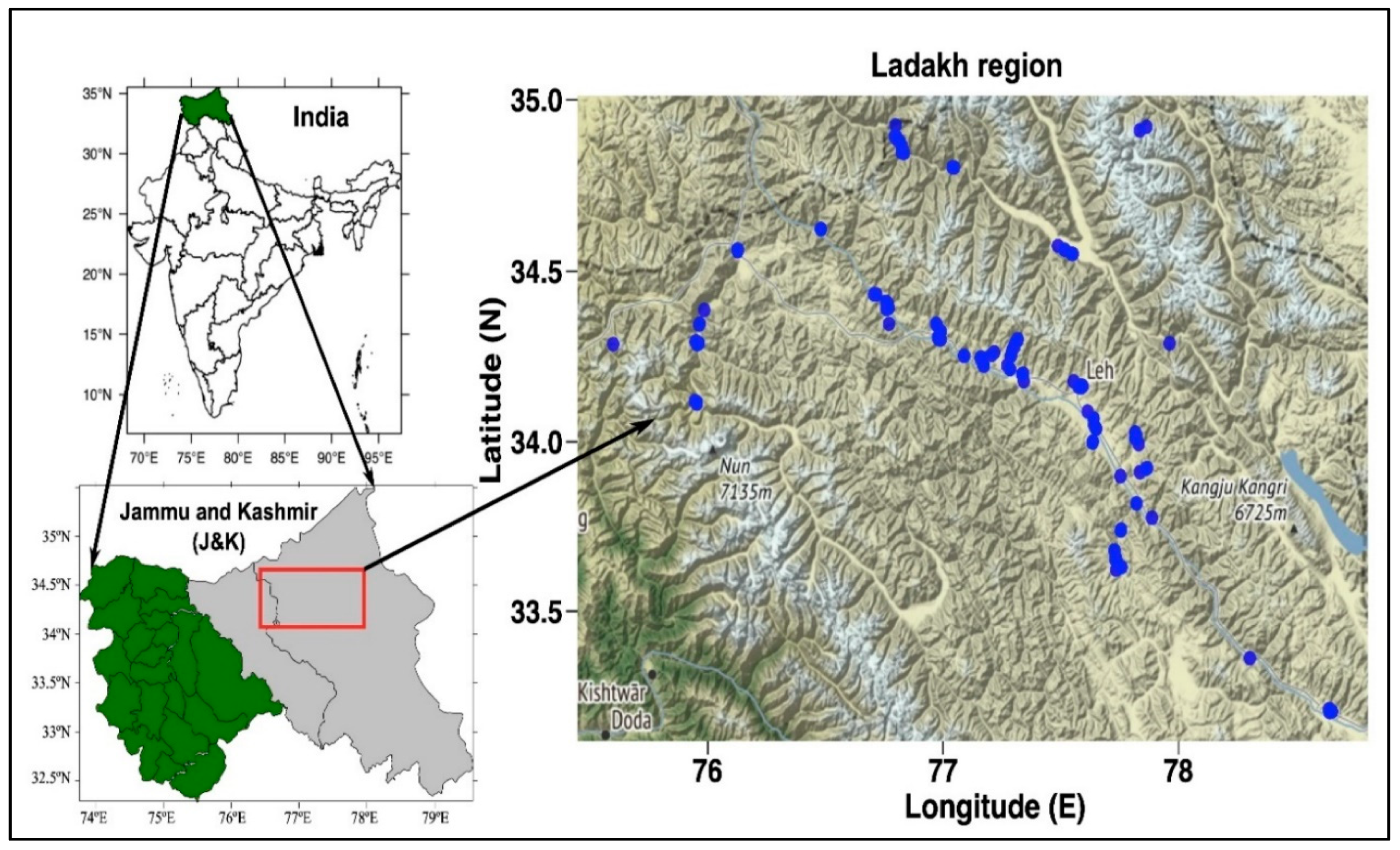
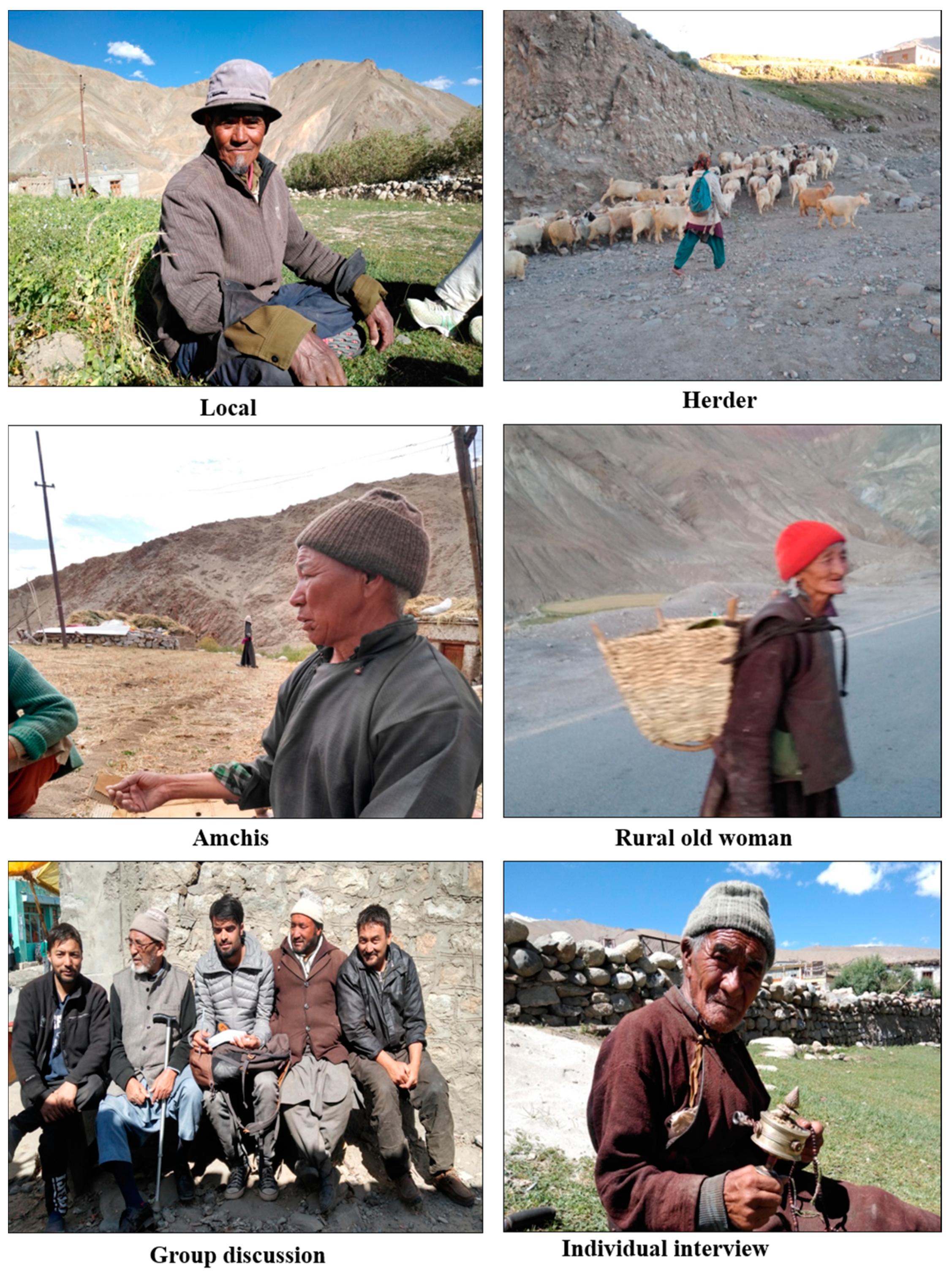
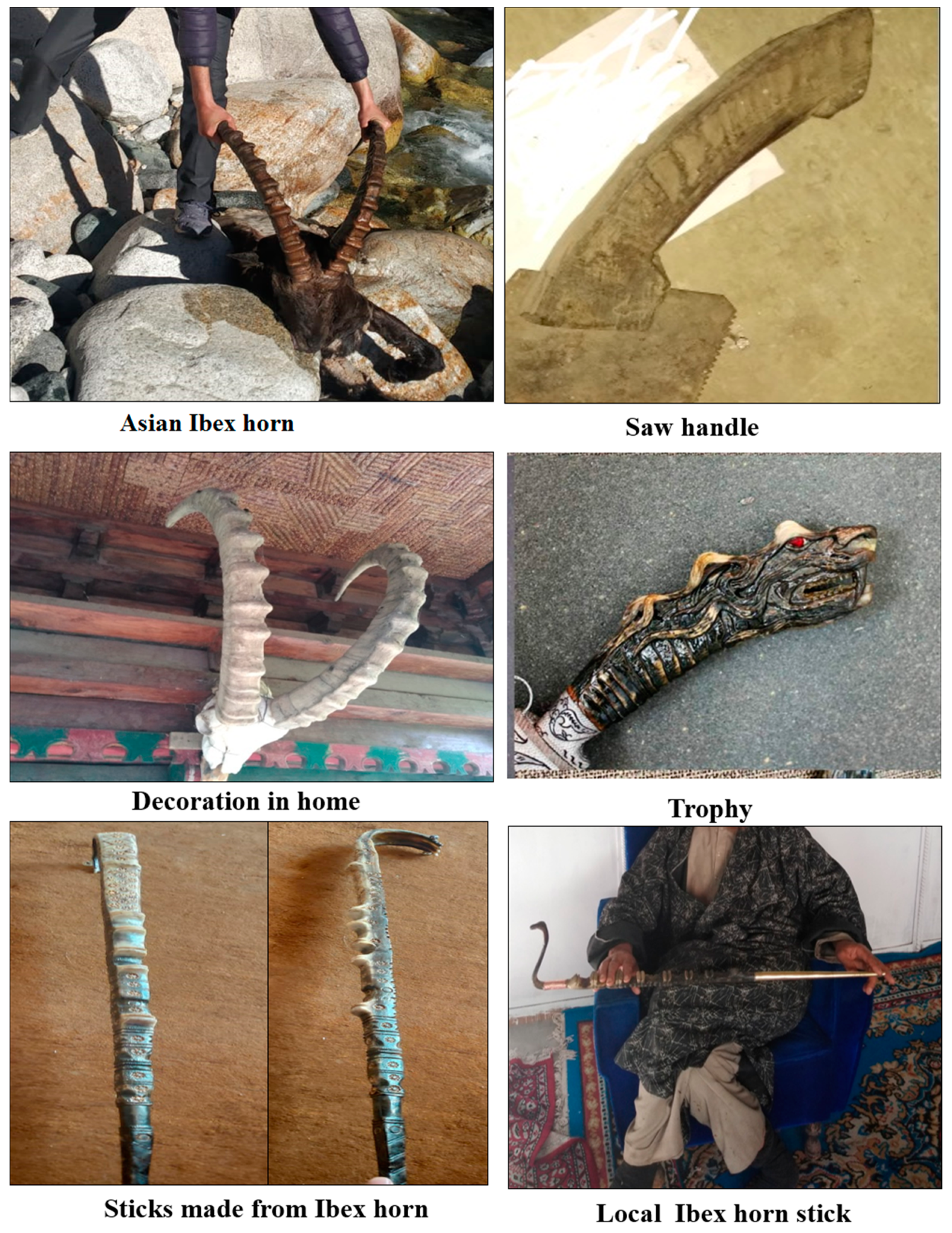
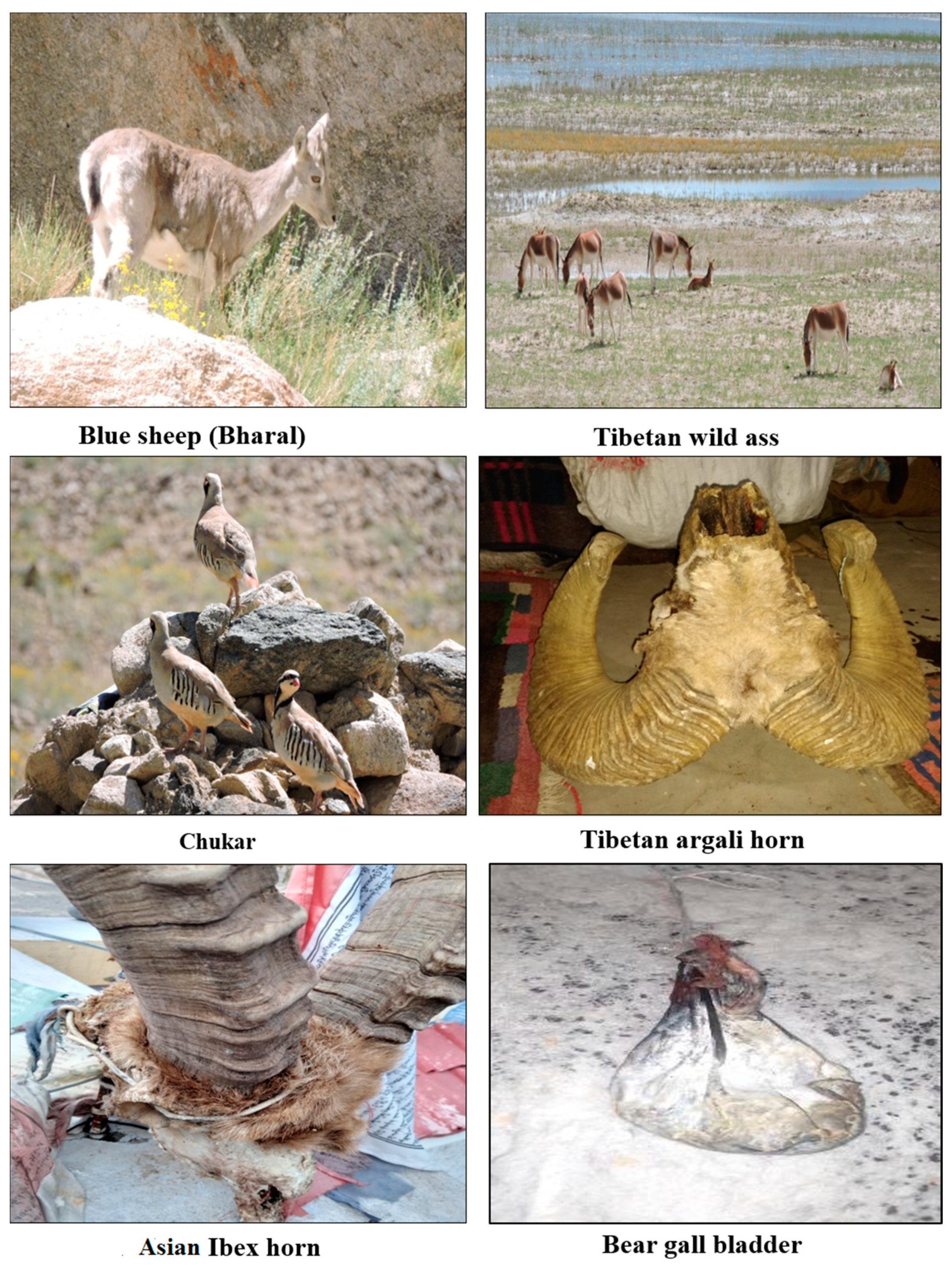



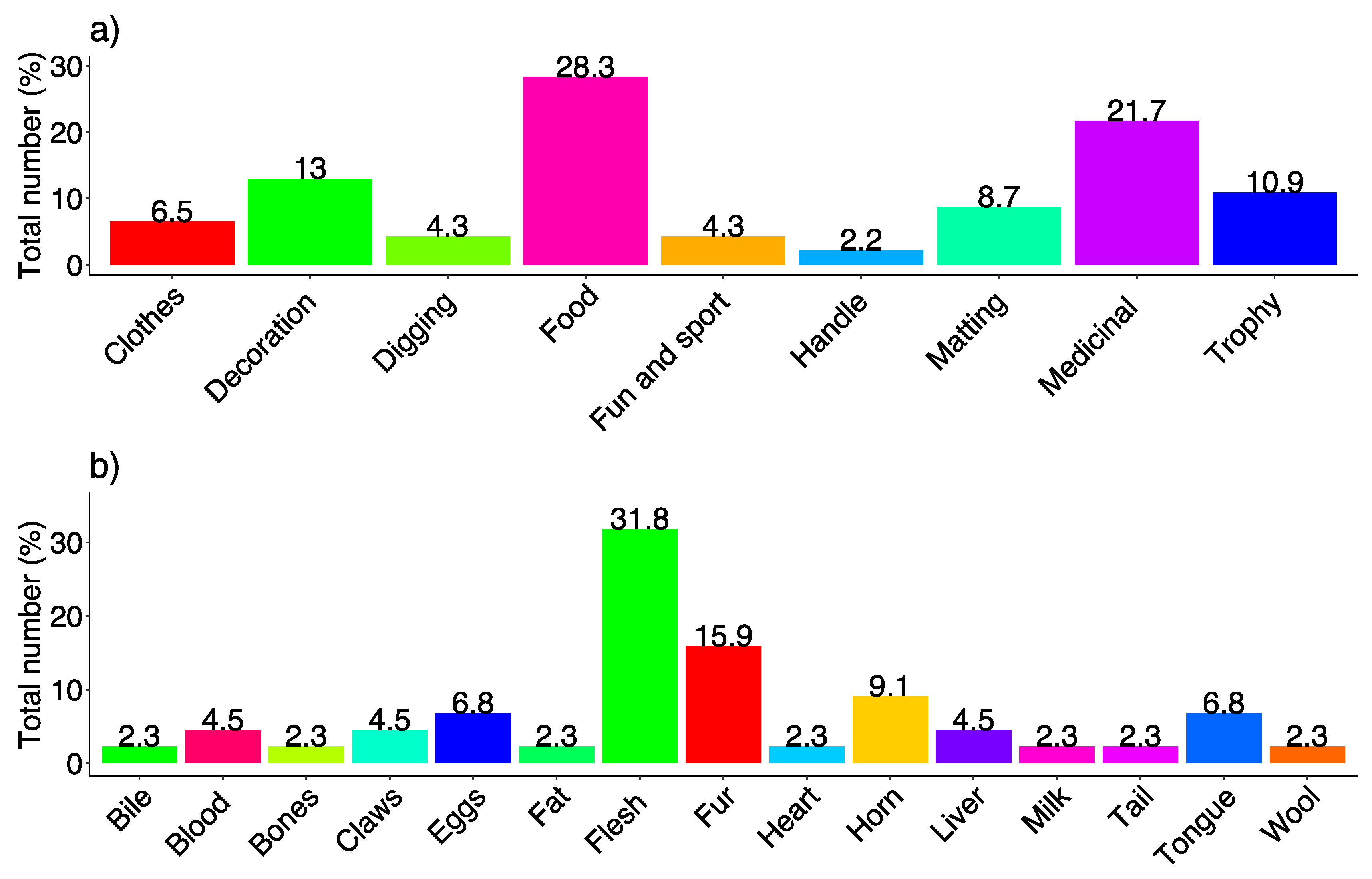
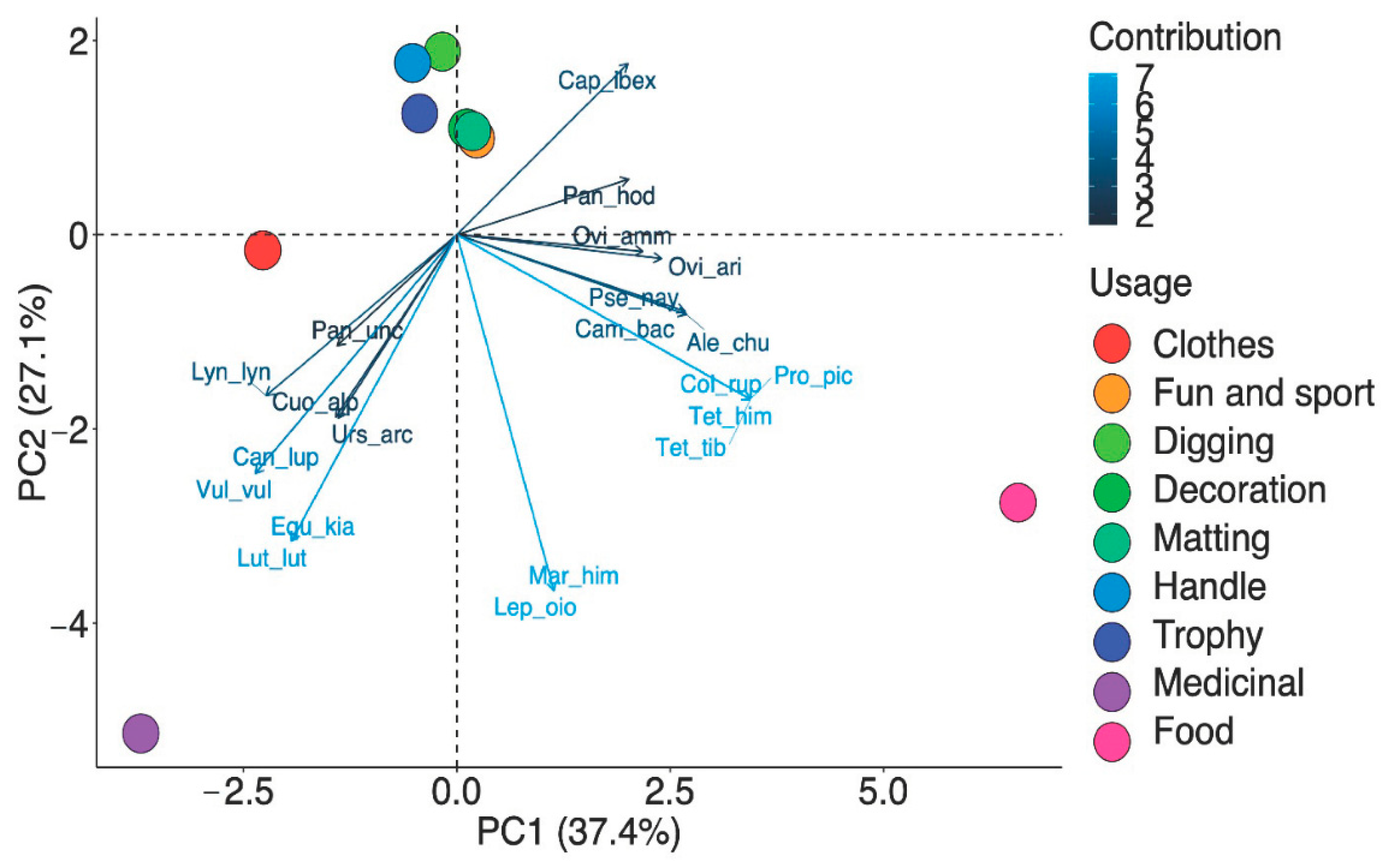
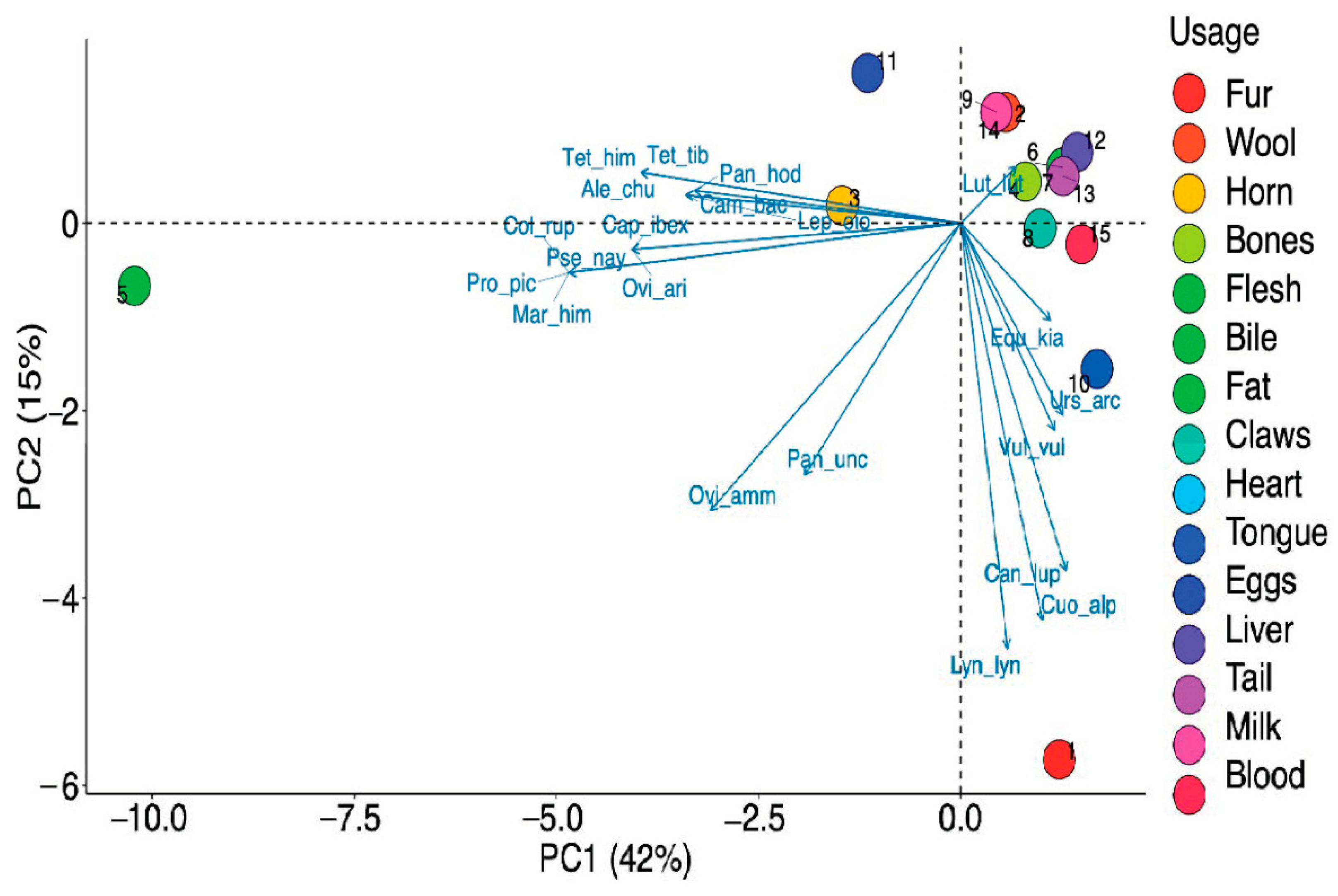
| Groups | Participants | |
|---|---|---|
| Respondents Interviewed | Shopkeepers | 13 |
| Farmers | 82 | |
| Daily wage laborer | 21 | |
| Hotel owners | 15 | |
| Museum owners | 2 | |
| Housewives | 52 | |
| Govt. employees | 23 | |
| Amchis | 21 | |
| Herders | 24 | |
| Hunters | 16 | |
| Age group | 25–45 | 33 |
| 46–65 | 128 | |
| 65–88 | 106 | |
| Gender | Male | 208 |
| Female | 61 | |
| Education qualification | 5th grade pass | 37 |
| 8th grade pass | 21 | |
| 10th grade pass | 15 | |
| 12th grade pass | 14 | |
| Graduate and above | 8 | |
| Illiterate | 174 | |
| Religion | Buddhist | 178 |
| Number | Muslim | 91 |
| Scientific Name | English and Local Name | Class Order Family | Traditional Uses | Medicinal Uses | Previous Use with Reference |
|---|---|---|---|---|---|
| Alectoris chukar J. E. Gray, 1830 | Chukar Srakpa | Aves Galliformes Phasianidae | Food (meat and eggs), Fun and Sports. | Meat soup is used for the treatment of paralysis | |
| Camelus bactrianus Linnaeus, 1758 | Double-hump camel Nabong | Mammalia Artiodactyla Camelidae | Food (meat), Fun and Sports. Used to treat black magic | Meat is used to gain body strength and vitality, also to relieve joint pain. Milk is used as sexual stimulant and antidote. | Meat stew is used to strengthen bones, relieve arthritis, and stiff limbs. Stomach is used to aid digestion, cure liver disease. Hump is believed to contain Qu tonic that softens human skin [34,41] |
| Canis lupus Linnaeus, 1758 | Tibetan wolf Shanku | Mammalia Carnivora Canidae | Medicine (TML), Clothing (fur is used for caps and gloves). | Tongue, stomach, and blood are used to cure inflammation, to increases digestion and treat diabetes, respectively. | Used to cure chicken pox, smallpox, mumps, varicella, asthma, measles, warts, menstrual cramps [42] |
| Capra sibirica Pallas, 1776 | Asiatic Ibex Skin | Mammalia Artiodactyla Bovidae | Food, Agriculture, Aesthetic (horn used for making handles, trophy). | Horns are crushed into powder form mixed with hot water and used against chest infections | Horns are used in traditional medicine [43] |
| Columba rupestris Pallas, 1811 | Pigeon Mukron | Aves Columbiformes Columbidae | Food (meat), Medicine (TML). | Dropping are used against inflammation. | Flesh gives physical strength and excreta dries away pus and heal swellings [44] |
| Cuon alpinus Pallas, 1811 | Asiatic wild dog Phara | Mammalia Carnivora Canidae | Clothing (fur is used in caps and gloves), Medicine (TML). | Tongue is used to cure ulcers | |
| Equus kiang Moorcroft, 1841 | Wild ass Khyang and Gorkhar | Mammalia Perissodactyla Equidae | Medicine, transport | Blood is used in rheumatism and eye disorders. And tongue is used in diarrhea. | Penis is used to enhance the men’s virility [45] |
| Lepus oiostolus Hodgson, 1840 | Hares Ribong | Mammalia Lagomorpha Leporidae | Food, Medicine (TML). | Dropping are used to treat skin diseases | |
| Lutra lutra Linnaeus, 1758 | Common Otter Eurasian Otter Chusham | Mammalia Carnivora Mustelidae | Medicine (TML) | Liver is used against reproductive disorders | |
| Lynx lynx Linnaeus, 1758 | Eurasian lynx Yie | Mammalia Carnivora Felidae | Aesthetic (fur), Medicine (TML). | Dried meat is used to overcome body weakness, arthritis. | Used against evil eye’’, arthritis, avoid acne, distend, earache, fever, leishmaniosis, making the child talk; pain in bones, rheumatism, scare, stomachache, wounds [46]. |
| Marmota himalayana Hodgson, 1841 | Marmots Phia | Mammalia Rodentia Sciuridae | Food, Medicine (TML). | Liver is used to treat bone disorders. | |
| Ovis ammon Linnaeus, 1758 | Tibetan argali Nyan | Mammalia Artiodactyla Bovidae | Food (meat), Aesthetic (Horns). | Meat is used to overcome protein deficiency in adults | Hunted for their meat and their horns for CTM [47] |
| Ovis aries vignei Blyth, 1841 | Ladakh Urial Shapo | Mammalia Artiodactyla Bovidae | Food (meat), Aesthetic (Horns for homes and shrines). | Meat is used in cough. | |
| Panthera uncia Schreber, 1775 | Snow leopard Shan | Mammalia Carnivora Felidae | Social cultural (meat used to protect young ones from black magic), Economic (bones, claws and fur mostly used as a source of income). | Bile is used to treat respiratory disorders; Dry meat is made into amulet to treat body weakness | Nails and Hairs are used to keep away evil spirits [48] |
| Pantholops hodgsonii Abel, 1826 | Tibetan antelope Szos | Mammalia Artiodactyla Bovidae | Clothing (Wool is used for making famous “Shahtoosh”). Aesthetic (Horns), Agriculture (Horns) | Horn is used in childbirth | |
| Procapra picticaudata Hodgson, 1846 | Tibetan gazelle Goa | Mammalia Artiodactyla Bovidae | Food (meat), Aesthetic (Horns). | Horn is used to treat diarrhea | |
| Pseudois nayaur Hodgson, 1833 | Blue sheep Napo | Mammalia Artiodactyla Bovidae | Food (meat), Aesthetic (Horns), Matting (fur) | Horn is used as an antibiotic. And hair is used as poisoning agent. | |
| Tetraogallus himalayensis G. R. Gray, 1843 | Himalayan snow cock Ripja | Aves Galliformes Phasianidae | Food (meat), Sometimes domesticated for “fun and sport” or source for eggs. | Meat is used against asthma and cough in children | |
| Tetraogallus tibetanus Gould, 1854 | Tibetan snow cock Ticok | Aves Galliformes Phasianidae | Food (meat), Sometimes domesticated for “fun and sport” or source for eggs. | Meat soup is used in the treatment of paralysis. And droppings against inflammation. | |
| Ursus arctos Linnaeus, 1758 | Brown bear Denmo | Mammalia Carnivora Ursidae | Medicine (bile and fat), and fur for matting and Aesthetic purposes. | Bile is used to treat pulmonary affliction. Fat is used for treatment of bone and joint pain. | Used to treat liver problem, to improve eyesight in fever fighting, inflammation, swelling and pain reduction. It was also used in the cure of carbuncle of heat type, pyocutaneous diseases and epilepsy [46]. |
| Vulpes vulpes Linnaeus, 1758 | Tibetan sand fox Watse | Mammalia Carnivora Canidae | Medicine (TML), Clothing (fur is used in caps and gloves). | Lungs are used in lung ulcer, meat is used to over back pain, and rheumatic pain. | Oil is obtained and used against jaundice [43] |
Publisher’s Note: MDPI stays neutral with regard to jurisdictional claims in published maps and institutional affiliations. |
© 2020 by the authors. Licensee MDPI, Basel, Switzerland. This article is an open access article distributed under the terms and conditions of the Creative Commons Attribution (CC BY) license (http://creativecommons.org/licenses/by/4.0/).
Share and Cite
Haq, S.M.; Calixto, E.S.; Yaqoob, U.; Ahmed, R.; Mahmoud, A.H.; Bussmann, R.W.; Mohammed, O.B.; Ahmad, K.; Abbasi, A.M. Traditional Usage of Wild Fauna among the Local Inhabitants of Ladakh, Trans-Himalayan Region. Animals 2020, 10, 2317. https://doi.org/10.3390/ani10122317
Haq SM, Calixto ES, Yaqoob U, Ahmed R, Mahmoud AH, Bussmann RW, Mohammed OB, Ahmad K, Abbasi AM. Traditional Usage of Wild Fauna among the Local Inhabitants of Ladakh, Trans-Himalayan Region. Animals. 2020; 10(12):2317. https://doi.org/10.3390/ani10122317
Chicago/Turabian StyleHaq, Shiekh Marifatul, Eduardo Soares Calixto, Umer Yaqoob, Riyaz Ahmed, Ahmed Hossam Mahmoud, Rainer W. Bussmann, Osama B. Mohammed, Khalid Ahmad, and Arshad Mehmood Abbasi. 2020. "Traditional Usage of Wild Fauna among the Local Inhabitants of Ladakh, Trans-Himalayan Region" Animals 10, no. 12: 2317. https://doi.org/10.3390/ani10122317
APA StyleHaq, S. M., Calixto, E. S., Yaqoob, U., Ahmed, R., Mahmoud, A. H., Bussmann, R. W., Mohammed, O. B., Ahmad, K., & Abbasi, A. M. (2020). Traditional Usage of Wild Fauna among the Local Inhabitants of Ladakh, Trans-Himalayan Region. Animals, 10(12), 2317. https://doi.org/10.3390/ani10122317







